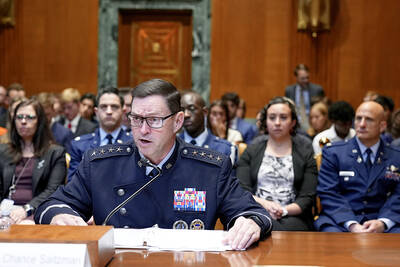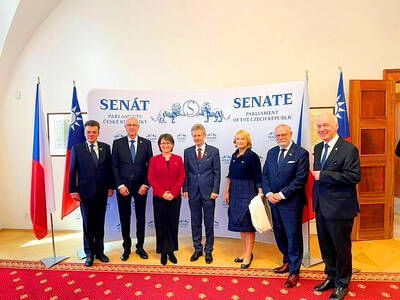Signaling a greater-than-ever military threat to Taiwan, new information emerged this week showing that China might be much further ahead in its development of a fifth-generation fighter aircraft than previously believed.
In what has caused a major stir within the Pentagon, Beijing Internet censors earlier this week allowed high-resolution photographs of the Chengdu Aircraft Corp stealth fighter to be published for the first time.
“For Taiwan, this means that even a sale of the latest versions of the Lockheed Martin F-16 will only provide a brief period of technical parity with the People’s Liberation Army,” Rick Fisher, a senior fellow at the International Assessment and Strategy Center in Washington, told the Taipei Times.
Fisher said it was now possible China could deploy significant numbers of the fifth-generation fighters — codenamed the Chengdu J-20 — within 10 years.
“There is now even greater reason for Taiwan to consider shifting its air defense resources to the more survivable short take-off fifth-generation F-35B, with modifications that increase its air combat potential,” he said. “Today, it is doubly tragic for Taiwan that Washington does not appear to be willing to sell either fighter to Taipei. Such a lack of resolve by Washington will only hasten the military confrontation it has successfully deterred since the Korean War.”
Taiwan is urgently pressing US President Barack Obama to sell it 66 advanced versions of the F-16, but with Chinese President Hu Jintao (胡錦濤) scheduled to visit Washington later this month, a sale is unlikely to be approved anytime soon.
Credible sources claim China could build at least 300 J-20s.
Aviation Week and Space Technology reported that China has begun flight-testing the J-20, which puts it only a few years behind the troubled F-35 Joint Strike Fighter, which is being developed by the US and a coalition of countries.
While it is possible that the newly released photographs of the J-20 are fakes, most US analysts believe them to be the real thing.
One military analyst said the plane had a chiseled front--section, triangular wings, all-moving tail-planes and seemed to combine the front fuselage of the US’ F-22 with the back half of the Russian T-50 stealth prototype.
“The J-20’s appearance could signal a big step forward for the Chinese air force, which to date relies mostly on airplanes bought from Russia or reverse--engineered from Russian or Israeli designs,” an analyst said.
Judging from the photographs, the J-20 is at least 21m from nose to tail, which means it would have a lower “supercruise” performance and agility than the F-22. However, with larger weapon bays and more fuel, it would have a longer range and carry more arms.
US military sources told the Taipei Times that China may be getting Russian help with the J-20 and that Moscow may be supplying 14.5 tonne thrust 117S engines for the plane, which is expected to double as a bomber.
Fisher said the J-20 could “supercruise,” or fly supersonically, for extended periods without using fuel-guzzling afterburners.
One commentator, writing on the Aviation Week and Space Technology Web site, said the new plane was “something to hang out at 50,000 feet [15.2km] over the Taiwan Strait with a large downward looking radar and serve up a large payload of AAM’s [air-to-air missiles] at anything underneath.”
Dean Cheng (成斌) of the Heritage Foundation think tank has linked the unexpected leak of the J-20 photographs with news earlier in the week that China had reached initial operational capability with a ballistic missile that may be capable of hitting and sinking an aircraft carrier, and reports that Beijing would soon launch a refurbished former Soviet aircraft carrier.
“All of these news items serve to underscore that China’s military development has proceeded more rapidly than many had expected and all of these military efforts are occurring without any pressing military threat to China’s borders or interests,” Cheng said.
“The US should never be afraid to engage the PRC [People’s Republic of China], but neither should it give the Chinese the impression that Washington is dealing with them out of fear. Only a consistent national security policy, including a sustained US presence in the region, can do that,” he said.

Two US House of Representatives committees yesterday condemned China’s attempt to orchestrate a crash involving Vice President Hsiao Bi-khim’s (蕭美琴) car when she visited the Czech Republic last year as vice president-elect. Czech local media in March last year reported that a Chinese diplomat had run a red light while following Hsiao’s car from the airport, and Czech intelligence last week told local media that Chinese diplomats and agents had also planned to stage a demonstrative car collision. Hsiao on Saturday shared a Reuters news report on the incident through her account on social media platform X and wrote: “I

SHIFT PRIORITIES: The US should first help Taiwan respond to actions China is already taking, instead of focusing too heavily on deterring a large-scale invasion, an expert said US Air Force leaders on Thursday voiced concerns about the Chinese People’s Liberation Army’s (PLA) missile capabilities and its development of a “kill web,” and said that the US Department of Defense’s budget request for next year prioritizes bolstering defenses in the Indo-Pacific region due to the increasing threat posed by China. US experts said that a full-scale Chinese invasion of Taiwan is risky and unlikely, with Beijing more likely to pursue coercive tactics such as political warfare or blockades to achieve its goals. Senior air force and US Space Force leaders, including US Secretary of the Air Force Troy Meink and

‘BUILDING PARTNERSHIPS’: The US military’s aim is to continue to make any potential Chinese invasion more difficult than it already is, US General Ronald Clark said The likelihood of China invading Taiwan without contest is “very, very small” because the Taiwan Strait is under constant surveillance by multiple countries, a US general has said. General Ronald Clark, commanding officer of US Army Pacific (USARPAC), the US Army’s largest service component command, made the remarks during a dialogue hosted on Friday by Washington-based think tank the Center for Strategic and International Studies. Asked by the event host what the Chinese military has learned from its US counterpart over the years, Clark said that the first lesson is that the skill and will of US service members are “unmatched.” The second

Czech officials have confirmed that Chinese agents surveilled Vice President Hsiao Bi-khim (蕭美琴) during her visit to Prague in March 2024 and planned a collision with her car as part of an “unprecedented” provocation by Beijing in Europe. Czech Military Intelligence learned that their Chinese counterparts attempted to create conditions to carry out a demonstrative incident involving Hsiao, which “did not go beyond the preparation stage,” agency director Petr Bartovsky told Czech Radio in a report yesterday. In addition, a Chinese diplomat ran a red light to maintain surveillance of the Taiwanese